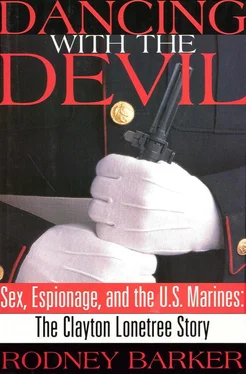In rapid succession Major Beck called his final two witnesses.
In their opening statement the defense had brought up the fact that Aleksei Yefimov, a.k.a. “Uncle Sasha,” had apparently for several years been an information source of a U.S. foreign service officer by the name of Shaun Byrnes. From this they had proposed a scenario in which Yefimov was in reality a double agent working for the CIA and Lonetree was a pawn used by the State Department to increase Yefimov’s standing in the KGB. It sounded farfetched to Major Beck, but nevertheless he had Shaun Byrnes flown in from Moscow to testify.
Under direct examination Byrnes acknowledged meeting regularly with Yefimov, who represented himself as an official with the State Committee for Science and Technology, but said it was to discuss Soviet domestic political developments. Byrnes explained that such unofficial contacts between the two governments was an accepted way of life, and approved by the ambassador. He said he had not been aware of Yefimov’s true profession, or of the fact that at the same time these meetings were taking place, in the role of “Uncle Sasha” Yefimov was recruiting Sergeant Lonetree. Only after Lonetree confessed and identified Yefimov from photos, Byrnes said, did he find out the truth, and then he was directed by Ambassador Hartman to confront Yefimov.
“What happened?” Major Beck asked.
“I asked him if he had known Sergeant Lonetree and if he had handled him. He looked me straight in the eye and told me he did not know Sergeant Lonetree, and had not ever known Sergeant Lonetree, and had not dealt with Sergeant Lonetree, and he asked me to pass that on to the ambassador and to Washington.” Byrnes said he did not believe Yefimov was telling the truth, and several weeks later Ambassador Hartman instructed him to break off the contact.
The defense wasn’t convinced. They thought the set of circumstances was too remarkable to be coincidental. One man’s spy was another man’s government-approved source? In cross-examination William Kunstler tried to illuminate this murky side of U.S. diplomatic relations with the Soviet Union, but other than eliciting the opinion that Byrnes thought Yefimov was “one of the sharpest Soviets I’ve ever dealt with,” defense counsel was unable to make any headway with the scenario that the two were involved in covert intelligence activities.
Last in line was Gus Hathaway, chief of the counterintelligence staff of the CIA. From Hathaway’s testimony Beck wanted the jury to hear why the U.S. government had intelligence officers overseas, and the contributions covert intelligence made to the national defense. He wanted him to talk about the time and money and resources, on both sides, that went into trying to identify the other’s agents. He wanted Hathaway to remind the members that these were real people, most with families, and, when their cover was blown, what the consequences were—to them personally, to human intelligence assets within the Soviet Union, and to national security, which was why there were espionage laws protecting them. When Hathaway was done testifying, the prosecution rested its case.
• • •
Throughout the trial the defense team had conducted a running battle with Judge Roberts. Time and again civilian counsel had complained that by limiting the scope of their questions, especially regarding intelligence matters, the judge was handcuffing the defense. Nevertheless, the broad outline of a defense theory had emerged through Stuhff and Kunstler’s cross-examination of prosecution witnesses. By the questions they asked and the objections they raised, it was clear that they were trying to establish that the accused’s statements had been obtained through the use of coercion and unlawful inducement. They had tried to throw doubt on the charge that their client had sold his country’s secrets by characterizing the information he passed as low level and already known by the Soviets. And they had done everything they could to impress upon the jury the idea that this was a case of a young man who was proud to be a Marine, who got caught up in a love affair, as so many men had over the centuries, but who, when he realized the situation he was in, being someone who had always wanted to be an American hero, had attempted to outwit the KGB. Which was a foolish mistake, the defense conceded, but he was no spy.
Now it was their turn to call witnesses who presumably would buttress their contentions, and expectations ran high. You needed a lot of evidence to sell a theory like that, and court observers were anxious to see how the defense intended to go about making its case. In the halls outside the courtroom people were whispering excitedly, “Now, we’re going to find out what Kunstler has up his sleeve.” Even Dave Beck was nervous, because in the military the defense did not have to declare its witnesses ahead of time, so he had been unable to prepare for what was coming. Having heard it alleged that Lonetree was a pawn in an intelligence scheme involving Uncle Sasha, he assumed the defense had a hole card it was going to play to back up that charge. And he certainly expected that Sergeant Lonetree would get up on the stand and present a version of his actions that supported what his defense attorneys had been saying. But for more than that he would have to wait.
When the defense submitted a list of five names that included two Marines friendly with Lonetree who would testify that he expressed pro-American sentiments in conversations with them, two expert witnesses who were going to testify about interrogation abuses and how they led to false confessions, and the former CIA employee and author Philip Agee, those books had publicly listed the names of hundreds of CIA agents, whom they expected to testify that it was easy for the Soviets to determine the identity of intelligence agents through a variety of methods, those in attendance were puzzled. Surely the defense had more than that going for them.
Rapidly it became clear they did not. When Judge Roberts denied permission to call all but the two Marine character witnesses, saying their testimony would be irrelevant to the charges against Sergeant Lonetree, Mike Stuhff made a motion for a mistrial on the grounds that the judge had “foreclosed our opportunity” to effectively present a defense before the jury. Roberts denied the motion with a rare public rebuke—“Counsel, you have with typical hyperbole expressed outrage at the rulings of the court [when] the notions of relevance you bring, quite frankly, take the breath way…. The court would not dream of reopening the case for the reasons stated”—and moments later the defense announced it would rest its case.
The silence in the courtroom was resounding. No one said anything, but everyone felt cheated, and the same thoughts ran through everyone’s mind: What? Wait a minute. I thought …
Outside the courtroom civilian counsel explained themselves.
“We’ve had a rough set of rulings on what the judge considers proper and relevant to bring to this jury,” Mike Stuhff told reporters. “He has very clearly restricted us from putting on a case. We think that he’s way out of bounds and clearly not allowing us to tell Sergeant Lonetree’s story.”
William Kunstler went even further. “This judge, who is totally programmed, is determined to convict the defendant if he can…. He is a disgrace.”
Asked why he did not let his client testify, Kunstler replied, “To ask him to make an emotional plea on behalf of himself subjects him to cross-examination. I don’t think he’s capable of handling that. If we put him on, I think Clayton would collapse under cross-examination.”
Despite putting on no witnesses, Stuhff said they were not conceding defeat. “Even with the hanging of the ball and chain the judge put on us, I think we put on a pretty good case.” When reporters asked him to elaborate, he said they scored numerous points for Lonetree during parts of the trial that were conducted behind closed doors.
Читать дальше












